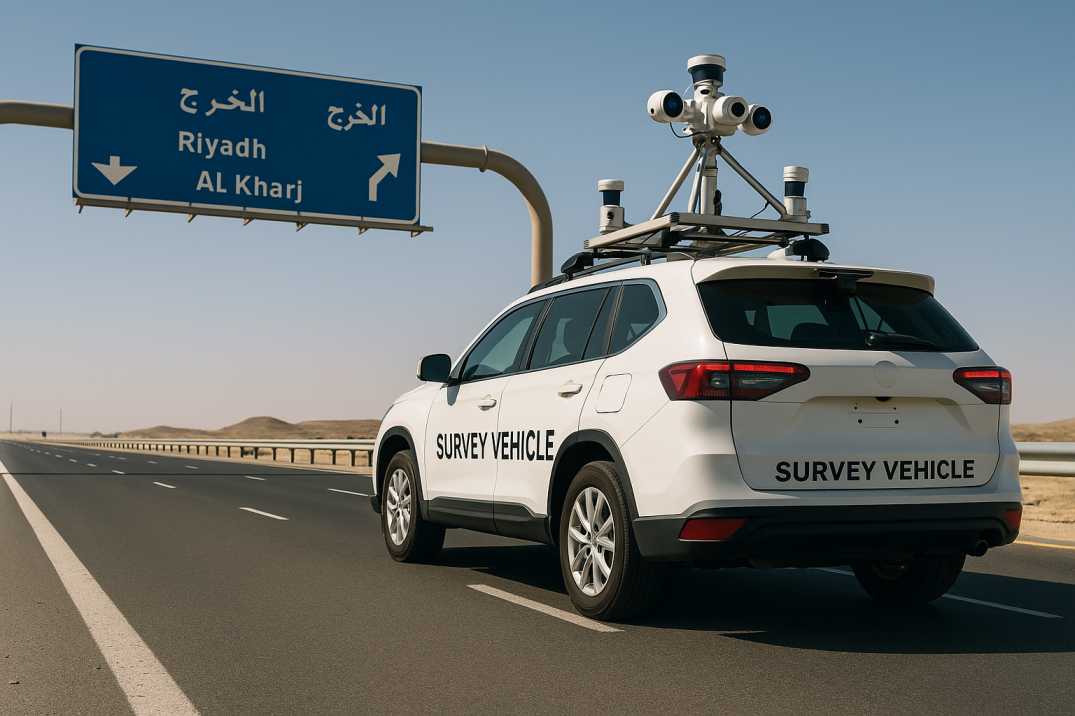Contact Us
RoadVision AI
Private Limited
Office No. 308 & 310, B Block
Ansal Chamber - 1, Bhikaji Cama Place,
Near Engineers India Limited (EIL) Bhawan, New Delhi - 110066
© 2024 | RoadVision AI | All rights reserved
The Kingdom of Saudi Arabia is rapidly expanding its transport infrastructure as part of Vision 2030, focusing on creating a safe, efficient, and modern road network. As the scale of construction grows, so does the need for precise and efficient road inventory inspection Saudi Arabia. Traditional manual inspection methods are increasingly being replaced by AI road inventory management and LiDAR-based solutions. These advanced technologies are enabling real-time, accurate, and cost-effective data collection, transforming road asset management Saudi Arabia and supporting national road safety and maintenance goals.

Road inventory data is the foundation of effective asset management. It includes information about pavements, signage, guardrails, lighting, drainage, and other roadside elements. According to official road infrastructure regulations in Saudi Arabia, maintaining an updated road asset database is essential for:
Manual methods of data collection often fall short due to human error, time constraints, and difficulty in surveying remote desert highways. This is why agencies are now adopting digital road asset inventory solutions powered by AI and LiDAR.
Artificial Intelligence (AI) is revolutionising the way road inventory inspection Saudi Arabia is carried out. By integrating AI algorithms with vehicle-mounted sensors and high-definition cameras, authorities can now collect large volumes of accurate, georeferenced data in a fraction of the time compared to traditional surveys.
Key benefits include:
This level of precision aligns with MOT and Saudi Transport Authority regulations for road condition assessment and asset maintenance.
LiDAR (Light Detection and Ranging) technology complements AI by providing detailed three-dimensional maps of road infrastructure. Mounted on vehicles or drones, LiDAR sensors scan road corridors at high speed, creating a precise 3D model of every asset and surrounding environment.
Advantages of LiDAR for digital road inventory management include:
This technology is particularly valuable for Saudi Arabia’s vast road network, where desert terrain and extreme weather conditions can accelerate asset deterioration.
Combining AI and LiDAR gives Saudi road authorities a powerful toolkit for road asset management Saudi Arabia. The integration allows:
With these technologies, Saudi Arabia can ensure compliance with national and Gulf Standardization Organization (GSO) road regulations while reducing inspection costs and improving public safety.
AI and LiDAR are transforming digital road asset inventory practices in Saudi Arabia. Automated road inventory inspection Saudi Arabia powered by AI algorithms and 3D LiDAR mapping delivers accurate, scalable, and cost-efficient solutions for maintaining the kingdom's rapidly growing road network. These technologies not only improve road asset management Saudi Arabia but also support better planning, proactive maintenance, and enhanced safety outcomes for all road users.
RoadVision AI is transforming road infrastructure development and maintenance with its innovative AI in road maintenance and AI in road construction solutions. By utilizing cutting-edge computer vision technology and digital twin models, the platform conducts comprehensive road safety audits, enabling the early detection of potholes, cracks, and other surface issues for timely repairs and enhanced road conditions. The use of AI in road safety also extends to traffic surveys, providing data-driven insights to tackle challenges like traffic congestion and optimize road usage. Focused on building smart roads, RoadVision AI ensures full compliance with IRC Codes, and aligns with SHC 101 and SHC 202 — Saudi Arabia’s official highway and infrastructure development codes — empowering engineers and stakeholders to reduce costs, minimize risks, and elevate road safety and transportation efficiency.
Book a demo with us to explore how RoadVision AI can help modernise road inventory data collection and management across Saudi Arabia.
Q1. What is road inventory inspection in Saudi Arabia?
It is the process of collecting and updating detailed information on road assets such as signage, lighting, and pavements, required for compliance with MOT standards.
Q2. How does AI improve digital road inventory management?
AI automates the detection, classification, and condition assessment of assets, reducing time and human error in data collection.
Q3. Why is LiDAR important for road asset management?
LiDAR provides precise 3D mapping of roadside infrastructure, improving inventory accuracy and supporting safer road planning.